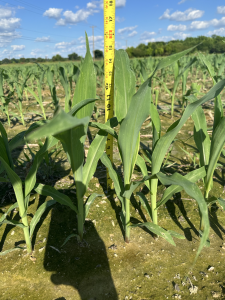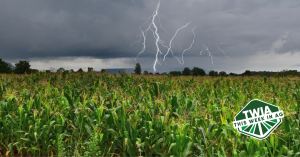When asked if he was finished with planting, dad would frequently respond by saying, “the first time.” His cynicism aside, replant decisions can be difficult. This year, too many growers are faced with that decision. If you plant when the soil is cold and wet, you’re inviting problems. But even if you plant in good soil conditions, subsequent rains, cold temperatures and other factors can impact crop emergence.
Before pulling the planter back out of the shed, farmers need to know exactly what they have. The first step is taking a stand count. That’s a smart move no matter how a crop stand looks, as it’s an excellent tool to assess early season performance of the crop inputs and planter and can help predict future yield potential. A popular method for determining stand counts is to measure 1/1000th of an acre, based on your row width, and count emerged plants. In my 38” rows, that’s 13’9”. Using a tape measure, I measured off 13’9” in various rows throughout my field. I then counted the number of plants within the measured area and multiplied them by 1,000. I replicated this process throughout my field, taking 20 samples (this may be overdoing it a bit, but I like being with my plants). I make sure to get representative samples planted by various row units of the planter, so I’m mindful of which rows I measure. My stand count was 46,700 plants per acre. I planted at 48,000 seeds per acre, so that’s a 97% emergence at the V4 stage, which is an excellent stand. Universities and seed companies have compiled lots of data to help growers make replant decisions, based on projected yield potential due to lower stand counts vs. projected yield potential due to later planting. Differences will vary based on the severity of the stand reduction, planting date and yield goal. Growers must weigh these options against the cost of seed (about $125 per are for corn), fuel and labor. These days, many seed companies and retailers will essentially “insure” crop stands, provided the grower uses their seed treatments. This could include covering anywhere from 50-100% of the replant seed costs, based on the crop and seed treatment. It often takes a severe stand reduction to justify replanting, especially in the Midwest. That’s because the later planting date compromises yield potential. It’s not uncommon for farmers to replant specific areas within a field.

My corn has been growing one inch per day since it was planted. Planting in ideal soil conditions, receiving 5.35” of rain and using Huma emergence products has made a big impact.

May kicks off the grilling season. It’s only fitting that May is #NationalBeefMonth. US cattlemen are the most efficient in the world, producing 18% of the world’s beef with only 6% of the world’s cattle. Americans dine on an average of 57 pounds of beef each year. Beef continues to come under scrutiny by certain politically charged groups, whose criticisms vary from improper land utilization to cow farts causing global warming. Yet those proficient in regenerative agriculture know that cattle can play a critical role in carbon capture and soil health.
John Deere has long been the bellwether of the ag industry. Last week Deere reported a 12% decline in their Q2 revenue over last year. For their year-to-date, revenues are 9% below last year. Deere has announced a series of layoffs over the past few months. This is in keeping with farmer sentiment (based on the Purdue Ag Economy Barometer), which fell 15 points in April, dropping to its lowest level in two years. A further reflection is the Farm Capital Investment Index, which dropped to its lowest level since tracking began in 2016.
Related Posts

This Week in Ag #12
#Plant23 is well underway. From the time seeds are sown, how many days should it take for crops to emerge? That can vary greatly, from days to weeks. But for many crops, it’s not really about calendar days, but Growing Degree Days (GDD).

This Week in Ag #28
The recent fertilizer market may be best described by two catch phrases: “wait-and-see” and “just in time.” In the fall of 2021, sky-rocketing energy prices pointed toward looming inflation and an inevitable rise in fertilizer prices. Many savvy growers, including those aligned with the regen ag movement, hedged their bets by purchasing crop nutrients that

This Week in Ag #63
“Plants sure know the difference between rainwater and hose water.” That was my wife’s observation Saturday morning, after seeing the rapid overnight growth, beautiful green color, and new blooms from our garden plants, following a thunderstorm that brought a half-inch of rain.

